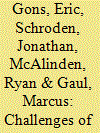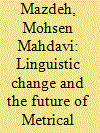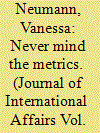| Srl | Item |
| 1 |
ID:
113109


|
|
|
|
|
| Publication |
2012.
|
| Summary/Abstract |
Measuring nationwide progress of counterinsurgency operations in Afghanistan using violence trends is difficult due to several factors: aggregation of data to the national level may obfuscate disparate local trends; the observed seasonality in violence makes comparisons difficult and may obscure progress; and short-term spikes or troughs - attributable to weather, military operations and tempo, or holiday periods - heavily influence simple averaging schemes. Despite these challenges, proper understanding of violence statistics is critical to estimating the effectiveness of military forces added during a surge or redeployed as part of transition. This article explores methods for analyzing observed violence trends to identify causal factors, to provide a comparable baseline, and to inform assessments at appropriate levels of aggregation. One methodology for seasonal adjustment of violence data is discussed and shown to provide a logical baseline for examining trends. An ordinary least squares regression model is developed and implemented using time-series violence data.
|
|
|
|
|
|
|
|
|
|
|
|
|
|
|
|
| 2 |
ID:
180016


|
|
|
|
|
| Summary/Abstract |
The metrical requirements of Persian poetry are highly restrictive. Traditionally, the rigidity of the metrical system was compensated for by a high degree of flexibility in the poetic language in terms of lexicon, phonology, and morpho-syntax. Using statistical data from different periods of Persian poetry, this paper argues that the degree of flexibility of the language used in metrical Persian poetry has been in constant decrease, moving towards what may potentially be a language crisis for metrical Persian poetry. This study traces the linguistic and meta-linguistic origins of the initial flexibility of the poetic language and its subsequent change, suggesting that some of the recent trends in Persian poetry may be viewed in part as reactions to this potential crisis.
|
|
|
|
|
|
|
|
|
|
|
|
|
|
|
|
| 3 |
ID:
091773


|
|
|
|
|
| Publication |
2009.
|
| Summary/Abstract |
Quantitative measures to gauge progress in a counterinsurgency in use today include the number of enemy, friendly, and civilian casualties, and the level of violence. While common, each of these has drawbacks. With this and the sparseness of the literature on this topic in mind, we argue for a series of improved measures. These include the ratio of who is initiating incidents, an historical analysis of incidents and related variables, and an analysis of insurgent target sets. These measures are presented using data for Al Anbar province, Iraq, along with a discussion of their advantages over more common metrics
|
|
|
|
|
|
|
|
|
|
|
|
|
|
|
|
| 4 |
ID:
177475


|
|
|
|
|
| Summary/Abstract |
Interconnectors reduce the cost of supplying electricity if they are operated efficiently. We show that established metrics which are used to monitor electricity trading inefficiency are inaccurate for several typical trading conditions. We propose two new metrics—the Unweighted and Price-Weighted Inefficient Interconnector Utilisation indices—to address these deficiencies. These metrics are substantially more accurate than existing ones and perform equally well whether or not interconnected markets have coupled trading. Our analyses show a substantial decrease in inefficient trading between Great Britain (GB) and both France and the Netherlands after the European Union's market coupling regulations were introduced in 2014.
|
|
|
|
|
|
|
|
|
|
|
|
|
|
|
|
| 5 |
ID:
138409


|
|
|
|
|
| Summary/Abstract |
Measuring and mapping human trafficking are challenging for several reasons and therefore do not lead to effective counter-trafficking strategies. Understanding the drivers of human migration, however, is a much more promising approach for developing policies with risk-mitigating strategies. Insofar as the patterns of human migration are intertwined with other aspects of illicit trade, they can serve as an early warning signal of vulnerabilities in the global trade system for criminal activity. Tracking the financial links between human trafficking and other crimes provides various options for effective degradation and disruption of illicit trafficking networks.
|
|
|
|
|
|
|
|
|
|
|
|
|
|
|
|
| 6 |
ID:
124064


|
|
|
|
|
| Publication |
2012.
|
| Summary/Abstract |
Technology should serve sailors, not micromanage them.
|
|
|
|
|
|
|
|
|
|
|
|
|
|
|
|